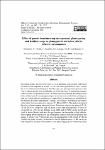Effect of potato-bean intercrop arrangement, plant spacing and fertiliser usage on plant growth and tuber yield in different environments
Date
2022Author
Nakibuule, J
Obala, Jimmy
Kigambo, M
Kajunju, N.H.B
Mugisha, J
Metadata
Show full item recordAbstract
In Uganda, potato (Solanum tuberosum. L) is an important cash and food crop but its
productivity has stagnated at around 3.5 t ha-1, far below potential (20 t ha-1), mainly
due to soil exhaustion resulting from land shortages, and poor agronomic practices. It is
vital to enhance production and efficient use of land resources by embracing elements
of the systems of crop intensification. The study aimed at generating knowledge on the
best combinations of crop management practices to increase productivity and improve
land use. A split-split plot randomised complete block experiment was established in
the districts of Kabale (high altitude), Rukiga (mid altitude), and Mbarara (descriptor
of elevation) for two consecutive seasons (2018B and 2019A). The study investigated
the effect of intercropping potato and beans (Phaseolus vulgaris) (in ratios of 1P:1B,
1P:2B, 2P:2B vs. sole potato, and sole bean), at two plant spacing levels (75 cm × 30
cm and 60 cm × 50 cm), and fertiliser usage (NPK and No NPK) on the growth and
yield of potato. Results indicated that performance was favourable at high altitude.
Intercropping potato and beans at the studied plant densities increased the quantity and
quality of potato yield. Whereas the intercrop arrangements of 1P:1B and 1P:2B out
yielded sole potato in tuber yield in the favourable highland areas; 1P:1B was at per
with sole potato in terms of marketable yield. Intercropping potato with beans in the 1P:2B arrangement increased potato yields by 1.2 t ha-1 and also contributed highly to
efficient utilisation of land resources (LER = 2.54) compared to sole potato. Addition
of NPK increased potato yield, more so at the 75 cm × 30 cm spacing.
Collections
- Research Articles [23]

